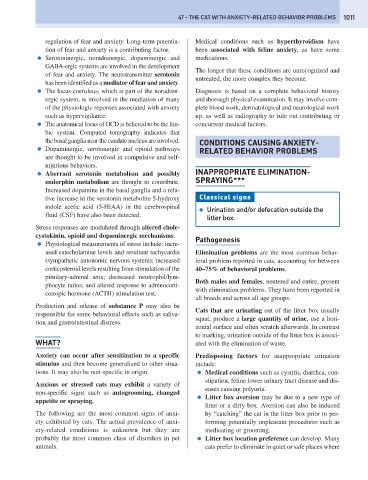Page 1019 - Problem-Based Feline Medicine
P. 1019
47 – THE CAT WITH ANXIETY-RELATED BEHAVIOR PROBLEMS 1011
regulation of fear and anxiety. Long-term potentia- Medical conditions such as hyperthyroidism have
tion of fear and anxiety is a contributing factor. been associated with feline anxiety, as have some
● Serotoninergic, noradrenergic, dopaminergic and medications.
GABA-ergic systems are involved in the development
The longer that these conditions are unrecognized and
of fear and anxiety. The neurotransmitter serotonin
untreated, the more complex they become.
has been identified as a mediator of fear and anxiety.
● The locus coeruleus, which is part of the noradren- Diagnosis is based on a complete behavioral history
ergic system, is involved in the mediation of many and thorough physical examination. It may involve com-
of the physiologic reponses associated with anxiety plete blood work, dermatological and neurological work
such as hypervigilance. up, as well as radiography to rule out contributing or
● The anatomical focus of OCD is believed to be the lim- concurrent medical factors.
bic system. Computed tomography indicates that
the basal ganglia near the caudate nucleus are involved. CONDITIONS CAUSING ANXIETY-
● Dopaminergic, serotonergic and opioid pathways RELATED BEHAVIOR PROBLEMS
are thought to be involved in compulsive and self-
injurious behaviors.
● Aberrant serotonin metabolism and possibly INAPPROPRIATE ELIMINATION-
endorphin metabolism are thought to contribute. SPRAYING***
Increased dopamine in the basal ganglia and a rela-
tive increase in the serotonin metabolite 5-hydroxy Classical signs
indole acetic acid (5-HIAA) in the cerebrospinal
● Urination and/or defecation outside the
fluid (CSF) have also been detected.
litter box.
Stress responses are modulated through altered chole-
cystokinin, opioid and dopaminergic mechanisms.
Pathogenesis
● Physiological measurements of stress include: incre-
ased catecholamine levels and resultant tachycardia Elimination problems are the most common behav-
(sympathetic autonomic nervous system); increased ioral problem reported in cats, accounting for between
corticosteroid levels resulting from stimulation of the 40–75% of behavioral problems.
pituitary-adrenal axis; decreased neutrophil/lym-
Both males and females, neutered and entire, present
phocyte ratios; and altered response to adrenocorti-
with elimination problems. They have been reported in
cotropic hormone (ACTH) stimulation test.
all breeds and across all age groups.
Production and release of substance P may also be
Cats that are urinating out of the litter box usually
responsible for some behavioral effects such as saliva-
squat, produce a large quantity of urine, use a hori-
tion and gastrointestinal distress.
zontal surface and often scratch afterwards. In contrast
to marking, urination outside of the litter box is associ-
WHAT? ated with the elimination of waste.
Anxiety can occur after sensitization to a specific Predisposing factors for inappropriate urination
stimulus and then become generalized to other situa- include:
tions. It may also be non-specific in origin. ● Medical conditions such as cystitis, diarrhea, con-
stipation, feline lower urinary tract disease and dis-
Anxious or stressed cats may exhibit a variety of
eases causing polyuria.
non-specific signs such as autogrooming, changed
● Litter box aversion may be due to a new type of
appetite or spraying.
litter or a dirty box. Aversion can also be induced
The following are the most common signs of anxi- by “catching” the cat in the litter box prior to per-
ety exhibited by cats. The actual prevalence of anxi- forming potentially unpleasant procedures such as
ety-related conditions is unknown but they are medicating or grooming.
probably the most common class of disorders in pet ● Litter box location preference can develop. Many
animals. cats prefer to eliminate in quiet or safe places where

